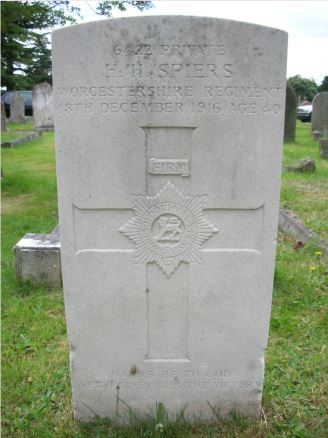3/7th Battalion, Worcestershire Regiment

Herbert Spiers’ time in the Army was very short and the circumstances of his death were unusual for the time and place.
Herbert Henry Spiers was born in Griffiths Town, near Pontypool, South Wales in 1876. His parents were William Henry Spiers, a lock keeper (1850-1901) and his wife Ann (née English: 1850-1938). The couple appears to have had eight children.
Notwithstanding his birthplace much of Herbert’s early live was spent in the Worcester area, with a period at Maisemore, near Gloucester.
On 5 March 1899 he married Ada Porter (1876-1953), a Gloucester girl, at St Catherine’s Church, Gloucester. They were both aged 22 and the marriage records indicate that Herbert worked as a labourer. According to the 1911 Census the couple had four children but only two had survived by 1911: Herbert Arthur (born 15 March 1901) and Reginald (born 23 February 1904).
The family lived at Barbourne, Worcester and in 1911 their address was 37 Waterworks Road; Herbert was a warehouseman for a ‘hired sack deposit’.
Herbert attested for military service, most likely under ‘Lord Derby’s Scheme’, the precursor of conscription, on 11 December 1915. He was then aged 39 and still employed as a warehouseman, now living at 55 Waterworks Road. Mobilisation into the Army did not follow until September 1916. The exact date is not clear from his surviving Army Service Record, which survived, in damaged form, enemy action in 1940. The record papers to include a report of a medical examination on 8 September 1916, so it is probable that this was on or about this date that he was mobilised.
He was posted as a Private (number 6422) to the 3/7th Battalion of the Worcestershire Regiment. This was a Territorial Force unit, acting in a ‘third line’ capacity for the purposes of training recruits and as a depot for moving recruits forward from the Reserve.
In October 1916 the battalion moved from Salisbury Plain to the Cheltenham area and in the following December Herbert fell ill. After an initial admission to a local military hospital, with suspected rheumatism, he was transferred to the Priory Red Cross Hospital in the town, in a semi-comatose state, running a high body temperature, suffering from incontinence and exhibiting a rash. By the 14th his condition had deteriorated and he had become delirious. Over the next few days his temperature continued to rise, reaching a dangerous 104 degrees Fahrenheit and he was now showing all the symptoms of having contracted typhus. In the days before antibiotics little if anything could be done for him and he finally died as a result of a high fever on 18 December, aged 40.
The Army authorities were unable to determine the source of the infection and whether it was down to his military service. Eventually this was acknowledged (a recently released Pension Record Card notes that it was a result of active service). Typhus is a disease spread by lice and outbreaks normally occurred where individuals were packed into inadequately sanitised buildings. There were outbreaks in a some prisoner of war camps in Germany and in places such as Russia, however, there is no mention in the Cheltenham newspapers of any local outbreak. Maybe Herbert was unlucky in his assignment of a billet.
So ended the very short Army career of Private Herbert Henry Spiers, who was buried in Cheltenham Cemetery on 20 December 1916, where standard CWGC headstone now marks his grave. He does not appear to be commemorated on the Barbourne War Memorial.
His widow did receive a pension award, effective from 26 May 1917 and never re-married.
Researched by Graham Adams 11 July 2020
